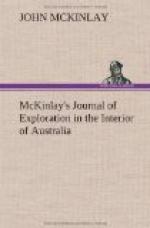Friday, October 11.
Started with the camels and Mr. Middleton, and a native named Bulingani, provisions and water, to go to the relief of the whites said to be in the interior, but at the same time with the intention of returning to camp if unsuccessful in finding a good camp for the animals. On a bearing of 18 degrees, at twenty-two miles, arrived at Lake Perigundi, a semicircular lake from three to four miles in length by one and three-quarter miles broad. The water not very good; the natives even dig round in the clay a short distance from the lake for water for their use. Appear friendly, and we saw about 200 of them—more rather than under that number, and looking remarkably healthy. Camped, surrounded by them on all sides except the lake side about 300 yards off. One of the camels got bogged and narrowly escaped. We kept watch and watch during the night, sending the native who was with us to camp with the blacks, who gave us some fish.
Saturday, October 12.
Up early and returned to camp. Found it deserted in consequence of instructions given to Mr. Hodgkinson previous to departure—that he was to examine the creek southward; and in the event of his finding good feed and water (which at the camp were both indifferent) to remove the camp at once, which he found, and consequently removed, leaving me a memo at an appointed place of his distance and direction, which was about one and a half miles south and west. Two of the working bullocks got off during my absence, and before they were overtaken by the blackfellow (Frank) on horseback, they had got down south as far as Lake Hope; so he reported on arrival.
Sunday, October 13.
Today I started Palmer and Jack on horseback to look after Frank and the bullocks, when they met with the bullocks coming back on their tracks; preparing for a start tomorrow, carrying a supply of water; name of our present camp, a fine long sheet of water, Wankadunnie; bears 220 degrees from the camp retreated from.
Monday, October 14.
Started with bullock-dray at 6.30 on a bearing of 18 degrees; after the first nine and a half miles travelled over undulating country of sand, dry flats, and flooded ground. From the top of the highest sandhill at that distance the whole country, particularly to the eastward, is one mass of flooded timbered flats and subject to awful inundations; at those times it must be quite impracticable—the main creek (apparently) upon our right varying from one or two and a half miles in width, with patches of young trees across its bed and sides. If this country had permanent water and rain occasionally it would do well for stock of any kind—having a fair sprinkling of grass compared with anything of late seen; and at fourteen miles on a bearing of 18 degrees came to, and crossed at an angle, the bed of a small dry lake (with lots of fine grass) or watercourse half a mile wide. When rain has fallen on this




